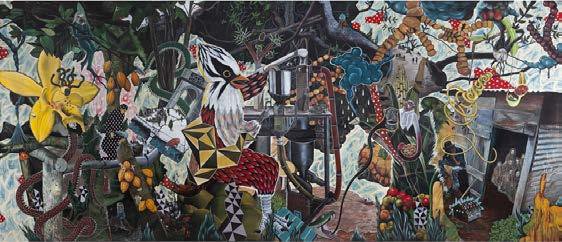Rodel Tapaya
dal 13/3/2014 al 25/4/2014
Segnalato da
13/3/2014
Rodel Tapaya
Arndt & Partner (new location), Berlin
In his expansive painting (The Chocolate Ruins) the blend of thematically related images impresses a conflated disquiet and a sense of simultaneous ironies. Speaking in the reconstructed and often esoteric language of folklore his works resurface age-old wisdom to comment on our contemporary life.

ARNDT Berlin. Rodel Tapaya is one of the leading Filipino visual artists of his generation and belongs to the
most acclaimed artists in Southeast Asia today. Due to exposure in international exhibitions and success in
important regional art contests his works have gained renown and critical indorsement. He broke out in the
art scene by earning the prestigious APB Foundation Signature Art Prize in 2011. Tapaya’s first one-man
exhibition at the Ateneo Art Gallery in Philippines - the country’s premier modern and contemporary art museum - is currently on display until April 2014. Tapaya’s first solo exhibition in Europe The Chocolate Ruins
will open at ARNDT Berlin from March 15, 2014 and will be on display until April 26, 2014.
Rodel Tapaya's main piece at ARNDT's primary location in Berlin resists blatant interpretation. In his expansive painting, The Chocolate Ruins, the blend of thematically related images impresses a conflated disquiet
and a sense of simultaneous ironies. Speaking in the reconstructed and often esoteric language of folklore -
myths and legends and their transfer in barbershop talk and current events - his works resurface age-old
wisdom to comment on our contemporary life. All the images are visually connected by parts of the cacao
plant, scattered across the canvas, each one dedicated to the three major disasters that has devastated the
Philippines during the past year; a magnitude 7.2 earthquake, Supertyphoon Haiyan, and the scandal over
widespread misuse of congressional funds.
Chocolates are easily a substitute for anything that corrupts, be it money, beauty, or tradition; an insinuation
to its prominent role in the bittersweet aspirations and decline of Imperial Spain's colonial rule over the Philippines. Other elements in the tragic tableau show vestiges of church ruins, makeshift shelters, storm clouds
with faces, and helpless men.
As our living and thinking increasingly adapt to the unremitting charge of information, artists like Rodel
Tapaya have developed an ability to isolate particular parts of this dissonance and arrange them in fresh
dramatic combinations. Tapaya has an awareness of the world as one would an ancient storyteller with insight developed in the context of the events that have altered into other things, and explores the implication
of these dynamic and inexhaustible symbols and narratives in relation to one another. In a time and place
when these myths and legends have become ruins as well, of national identity, the painter looks not to new
discoveries to catalogue the human condition, but rather pathways among the thicket of things already
known to our ancestors and his nation's literary heritage.
A publication - surveying his oeuvre of the past 10 years - edited on the occasion of Tapaya’s solo show
Bato-Balani at the Ateneo Art Gallery, Quezon City, Philippines will be launched during the Art Fair Philippines and also presented at the Berlin opening of The Chocolate Ruins.
Image: Rodel Tapaya, The Chocolate Ruins, 2014, Acrylic on canvas, 304,8 x 731,52 cm | 120 x 288
For more information and images please contact Karina Rozwadowska: karina@arndtberlin.com or +49 30 206 13 870.
Arndt
Potsdamer Straße 96 - 10785 Berlin
Tuesday to Saturday: 11 am to 6 pm and by arrangement



